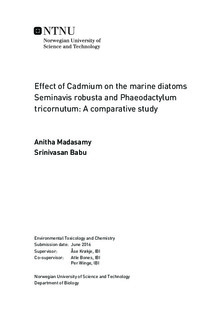Effect of Cadmium on the marine diatoms Seminavis robusta and Phaeodactylum tricornutum: A comparative study
Master thesis
Permanent lenke
http://hdl.handle.net/11250/2393938Utgivelsesdato
2016Metadata
Vis full innførselSamlinger
- Institutt for biologi [2571]
Sammendrag
Background: Heavy metals cause a harmful effect on marine ecosystems because of theirtoxicity, persistence and bioaccumulation properties. Cadmium (Cd) is speculated to be aunique heavy metal due to its diverse toxic effects. It is released into the environment throughpoint sources and also capable of long range transports. An extensive laboratory study wascarried out in order to explore the toxic effects of cadmium on diatoms. Diatoms were chosenas the study organisms because of their vital role as primary producers in the marine ecosystem.Experiment: Two marine benthic diatom species Seminavis robusta and Phaeodactylumtricornutum were separately cultured in aquil medium and exposed to seven differentconcentrations of cadmium (Cd2+) (0.01, 0.05, 0.25, 1.25, 6.25, 31.25, 156.25 mg/l) forapproximately 4 days (day and night cycles). The toxic effects were analyzed in three differentbiological levels. Growth rate (at population level), chlorophyll fluorescence and cellgranularity (at cell physiology level) and gene expression changes (at molecular transcriptionlevel) were analyzed.Results and conclusion: In Seminavis robusta, cadmium at low level concentrations issuggested to induce the expression of CA1 gene that might have resulted in the increase ofgrowth rate. In Phaeodactylum tricornutum, the overall growth rate did not seem to besuppressed by cadmium. Genes responsible for the cellular uptake of cadmium, VIT1 and ZIPT1were induced in P. tricornutum, while S. robusta did not show an indication of uptake ofcadmium through these genes. NTF2L gene was shown to be significantly (p=0.001)upregulated at very high levels of cadmium in S. robusta. A similar trend was observed in P.tricornutum (p=0.01). The role of NTF2L in cadmium efflux in diatoms is presented for thefirst time in this study. The genes used to monitor oxidative stress, CAT1, SOD1, GSR2 werenot significantly activated in any of the two species on exposure to cadmium under the givenexperimental conditions. The results of this study do not support the hypothesis that S. robustadue to its expanded gene inventory, shows a better tolerance to heavy metal stress.
